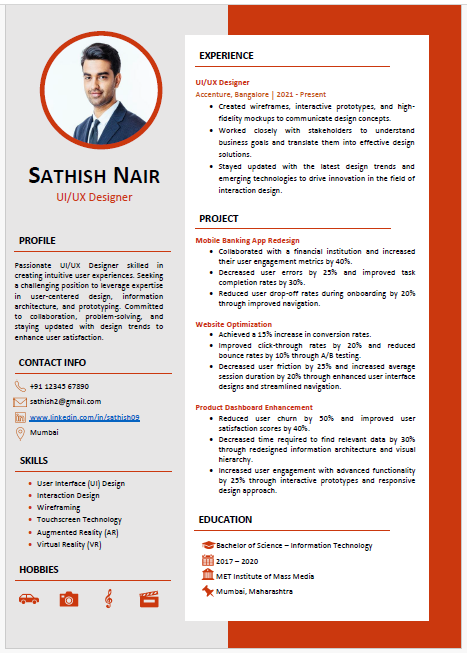UI/UX Designer
Bachelor of Science

About this template
This is a well-designed resume which can make a significant difference in capturing the attention of hiring managers and landing your dream job.
This resume is made by MS Word, featuring a clean and modern layout designed to highlight your skills and achievements.
Some most common and important technical skills for UI/UX Designer
For UI/UX Designers, blending user-centric design principles with technical aptitude is essential to create engaging and effective interfaces. Here are ten critical technical skills for UI/UX Designers:
1. User Research:
Mastery of user research methodologies is crucial for understanding user needs and behaviors. Techniques like interviews, surveys, and usability testing help in gathering insights that drive the design process.
2. Wireframing and Prototyping:
Skills in creating wireframes and prototypes are essential for visualizing and testing design concepts. Tools like Sketch, Adobe XD, and Figma facilitate the creation of low and high-fidelity prototypes to refine user flows and interactions.
3. Responsive Design:
Understanding responsive design principles ensures that designs function well across different devices and screen sizes. This includes proficiency in grid systems, flexible layouts, and media queries.
4. Interaction Design:
Proficiency in interaction design enhances the usability and appeal of products. This involves creating interactive elements that are intuitive and engaging for users.
5. Visual Design:
Strong visual design skills are necessary to create aesthetically pleasing and coherent interfaces. This includes color theory, typography, and layout techniques to enhance the user experience.
6. User Interface Development:
Basic knowledge of HTML, CSS, and JavaScript helps designers understand the possibilities and limitations of web technologies and collaborate effectively with developers.
7. Information Architecture:
The ability to organize information and content logically and effectively is key. Skills in developing clear navigation systems ensure that users can find information easily and intuitively.
8. Usability Testing:
Conducting usability testing and analyzing user feedback to iterate and improve designs is crucial. Familiarity with testing tools and methods allows designers to refine interfaces based on real user interactions.
9. Accessibility Standards:
Knowledge of web accessibility standards (WCAG) is important to create designs that are usable by everyone, including people with disabilities. This involves designing with accessibility in mind from the outset.
10. Design Software Proficiency:
Expertise in design and prototyping software like Adobe Creative Suite, Sketch, and Figma is fundamental. These tools are used to create detailed designs, mockups, and animations that bring user interfaces to life.
Conclusion:
These technical skills enable UI/UX Designers to create functional, accessible, and visually appealing designs that meet user needs and business goals effectively.